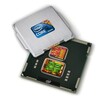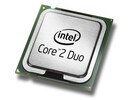Intel Core i5-580M vs Intel Core 2 Duo P8600 vs Intel Core 2 Duo P9700
Intel Core i5-580M
► remove from comparison
Der Intel Core i5-580M ist ein zwei-Kern Prozessor für Notebooks und taktet dank Turbo mit 2.67 - 3.33 GHz. Die zwei Kerne basiert auf die Nehalem (Westmere) Mikro-Architektur und können dank Hyperthreading 4 Threads gleichzeitig abarbeiten.
Eine Besonderheit der Arrandale Dual-Core CPUs von Intel ist die Integration des Speichercontrollers (für DDR3-800/1066) und einer integrierten Grafikkarte (GMA HD) in das Package. Die CPU wird bereits in 32nm hergestellt, der Die für den Speichercontroller und die Grafikkarte jedoch noch in 45nm.
Die Performance des i5-580M liegt aufgrund des kleineren Level 3 Cache knapp unterhalb des gleich-getakteten Core i7-620M. Damit ist er der zweitschnellste mobile Doppelkernprozessor für Notebooks und im Schnitt schneller als alle Core 2 Duo Modelle. Dank HyperThreading kann der 580M auch langsam getaktete Quad Core CPUs in Multi-Threaded Anwendungen schlagen. Daher sollte der Prozessor für fast alle aktuellen Spiele und Anwendungen genügend Rechenleistung bieten (Anfang 2010).
Die 32-nm-Prozessorkerne der Westmere-Generation verarbeiten auch einige neue Befehle, die AES-Verschlüsselung beschleunigen sollen.
Die integrierte Intel Graphics Media Accelerator HD (GMA HD) Grafikkarte soll nach ersten Berichten mit bis zu 500-766 MHz getaktet werden (ev. auch mit Turbo Boost) und deutlich schneller werden als die alte GMA 4500MHD. Eine GeForce 9400M (ION) wird jedoch noch minimal schneller bleiben (mit besserem Treibersupport für Spiele).
Der Stromverbrauch ist mit einem TDP von 35 Watt zwar genauso hoch wie bei den T-Modellen der Core 2 Duo Serie, jedoch beinhaltet der TDP beim Core i5 auch die Grafikkarte und den Speichercontroller (beim Core 2 Duo waren diese noch im Chipsatz). Dadurch ist der Stromverbrauch des ganzen Systems wohl geringer. Unter Last wird der TDP durch den Turbo jedoch eher ausgereizt, wordurch der Stromverbrauch über vergleichbaren Core 2 Duo P-Modellen ausfallen kann (Idle deutlich darunter).
Intel Core 2 Duo P8600
► remove from comparison
Der Intel Core 2 Duo P8600 Dual-Core Prozessor bietet zwei Prozessorkerne mit einem gemeinsamen Level 2 Cache von 3 MB. Im Vergleich zu den stärkeren Modellen bietet, der P8600 zwar nur die Hälfte an Level 2 Cache, jedoch bleibt dadurch der Stromverbrauch mit maximal 25 Watt auch geringer. Die Architektur des Prozessors basiert auf den Penryn Kern und wird in 45nm gefertigt.
Dank der relativ hohen Taktung von 2.4 GHz, ist die Performance jedoch für die meisten Spiele in 2009 ausreichend (nur GTA 4 profitiert deutlich von einem schnelleren Prozessor). Im Vergleich zu AMD Prozessoren, schlägt der P8600 den derzeit schnellsten Turion II Ultra M640 deutlich (dieser ist auf dem Niveau des 2.26 GHz schnellen Core 2 Duo P8400).
Der Penryn (Montevina Update) Kern bietet 2 Integer Units, 1 Floating Point Unit, 1 Load Unit und 1 Store Unit in einer 14-stufigen Pipeline. Mit der Wide Dynamic Execution Technologie kann der Kern bis zu vier volle Instruktionen gleichzeitig ausführen.
Dank Dynamic Acceleration (später Turbo Modus genannt), kann sich ein Kern um eine Stufe übertakten, wenn der zweite im Idle Modus (Leerlauf) ist.
Das integrierte Enhanced Speedstep kann die Taktfrequenz des Prozessors dynamisch an die Leistungsanforderungen anpassen. Dadurch läuft die CPU ohne Last nur mit 1200 MHz.
Der Core 2 Duo P8600 passt in den Socket P (mit 479 Pins):
Socket P / Micro Flip-Chip Pin Grid Array (Micro-FCPGA) requires 479-pin surface mount Zero Insertion Force (ZIF) socket (mPGA479M socket) or Micro Flip-Chip Ball Grid Array (Micro-FCBGA) for surface mount (479-ball)
Intel Core 2 Duo P9700
► remove from comparison
Der Intel Core 2 Duo P9700 ist ein schneller und trotzdem sparsamer Doppelkernprozessor der Penryn Reihe für Notebooks. Die CPU ist die schnellste Variante der Core 2 Duo P-Serie, braucht jedoch mit 28 Watt etwas mehr Strom als die kleineren P-Modelle. Im Vergleich zur T-Serie (welche mit 35 Watt spezifiziert ist), ist der P9700 jedoch sparsam.
Die Performance des Core 2 Duo P9700 ist vergleichbar mit dem ebenfalls mit 2.8 GHz getakteten Core 2 Duo T9600 und dadurch sollte sie für die alle Spiele in 2009 ausreichen (nur GTA 4 profitiert deutlich von mehr Prozessorkernen). Die alten Core 2 Quad Mobilprozessoren (Q9000, QX9300) werden dank der hohen Taktung des P9700 bei den meisten Spielen geschlagen (da Spiele aus 2009 meist nicht mehr als 2 Kerne auslasten).
Der Penryn (Montevina Update) Kern bietet 2 Integer Units, 1 Floating Point Unit, 1 Load Unit und 1 Store Unit in einer 14-stufigen Pipeline. Mit der Wide Dynamic Execution Technologie kann der Kern bis zu vier volle Instruktionen gleichzeitig ausführen.
Dank Dynamic Acceleration (später Turbo Modus genannt), kann sich ein Kern um eine Stufe übertakten, wenn der zweite im Idle Modus (Leerlauf) ist.
Das integrierte Enhanced Speedstep kann die Taktfrequenz des Prozessors dynamisch an die Leistungsanforderungen anpassen.
| Model | Intel Core i5-580M | Intel Core 2 Duo P8600 | Intel Core 2 Duo P9700 | ||||||||||||||||||||||||||||||||||||||||||||||||||||
| Series | Intel Core i5 | Intel Core 2 Duo | Intel Core 2 Duo | ||||||||||||||||||||||||||||||||||||||||||||||||||||
| Codename | Arrandale | Penryn | Penryn | ||||||||||||||||||||||||||||||||||||||||||||||||||||
| Serie: Core 2 Duo Penryn |
| ||||||||||||||||||||||||||||||||||||||||||||||||||||||
| Clock | 2666 - 3333 MHz | 2400 MHz | 2800 MHz | ||||||||||||||||||||||||||||||||||||||||||||||||||||
| FSB | 4800 | 1066 | 1066 | ||||||||||||||||||||||||||||||||||||||||||||||||||||
| L1 Cache | 128 KB | 128 KB | 128 KB | ||||||||||||||||||||||||||||||||||||||||||||||||||||
| L2 Cache | 512 KB | 3 MB | 6 MB | ||||||||||||||||||||||||||||||||||||||||||||||||||||
| L3 Cache | 3 MB | ||||||||||||||||||||||||||||||||||||||||||||||||||||||
| Cores / Threads | 2 / 4 | 2 / 2 | 2 / 2 | ||||||||||||||||||||||||||||||||||||||||||||||||||||
| TDP | 35 Watt | 25 Watt | 28 Watt | ||||||||||||||||||||||||||||||||||||||||||||||||||||
| Transistors | 382+177 Million | 274 Million | 410 Million | ||||||||||||||||||||||||||||||||||||||||||||||||||||
| Technology | 32 nm | 45 nm | 45 nm | ||||||||||||||||||||||||||||||||||||||||||||||||||||
| Die Size | 81+114 mm2 | 81 mm2 | 107 mm2 | ||||||||||||||||||||||||||||||||||||||||||||||||||||
| max. Temp. | 105 °C | 105 °C | 105 °C | ||||||||||||||||||||||||||||||||||||||||||||||||||||
| Socket | BGA1288, PGA988 | Socket P (BGA479, PGA478) | PGA478 | ||||||||||||||||||||||||||||||||||||||||||||||||||||
| Features | Turbo Boost, Hyper Threading, Enhanced Speedstep, integrierte GMA HD 500-733MHz, Dual Channel DDR3 memory controller | SSE4.1, Virtualization Technology, Execute Disable Bit, Enhanced Speedstep, Ehnaced Halt State (C1E), 64 Bit, Trusted Execution Technology | Virtualization (VT-x), Trusted Execution, Intel 64, Enhanced Speedstep, Execute Disable Bit | ||||||||||||||||||||||||||||||||||||||||||||||||||||
| Architecture | x86 | x86 | x86 | ||||||||||||||||||||||||||||||||||||||||||||||||||||
| $266 U.S. | $209 U.S. | $348 U.S. | |||||||||||||||||||||||||||||||||||||||||||||||||||||
| Announced | |||||||||||||||||||||||||||||||||||||||||||||||||||||||
| Manufacturer | ark.intel.com | ark.intel.com | ark.intel.com | ||||||||||||||||||||||||||||||||||||||||||||||||||||
| Voltage | 1-1.25 V V | 1.012-1.175V V |


 Deutsch
Deutsch English
English Español
Español Français
Français Italiano
Italiano Nederlands
Nederlands Polski
Polski Português
Português Русский
Русский Türkçe
Türkçe Svenska
Svenska Chinese
Chinese Magyar
Magyar
